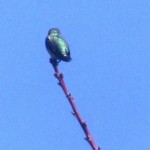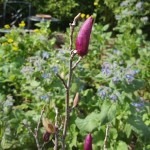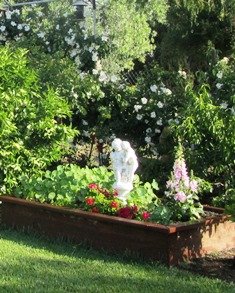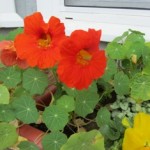Helping the Hummers Refuel
In a single day of darting to and from colorful flowers, the tiny hummingbird consumes nearly half its weight in sugar as it searches for nectar-rich blossoms.

A hummer’s iridescent feathers shimmer as it perches in sunlight at the end of an apricot tree branch
Their wings beat so rapidly, they make a purring sound. Ever industrious, these tiny birds work from dawn to dusk. They are drawn to tubular-shaped flowers or brightly colored ones in shades of red, orange, blue, and pink.
If you want to help the hummers refuel, consider putting flowers on your patio or in your garden that appeal to these little energy burners. Or, better still, plant trees, vines, perennial, and annual plants that will produce the flowers that attract hummers. Choose from the list below.

Behind the unfurled buds of the Jane magnolia are the blue blossoms of Borage, an herb frequented by bees, butterflies, and hummers
Annuals: Borage (blue star flower), impatiens, flowering tobacco, petunia, plox, salvia, and snapdragon
Perennials: aloe, alstomeria, bee balm, California fuschia, cardinal flower, columbine, coral bells, foxglove, gladiolus, parrot’s beak, monkey flower, salvia, and sage
Vines: blood red trumpet vine, cape honeysuckle, lonicera (honeysuckle), flame vine, and trumpet creeper
Trees: acacia, chinaberry tree, citrus, coral tree, eucalyptus, silk tree, and tulip tree
______________________________________________________________________
If you enjoy reading about gardening, keeping chickens and bees, and other backyard farming topics, check out my series of cozy mysteries, including A BEELINE TO MURDER, THE MURDER OF A QUEEN BEE, and A HIVE OF HOMICIDES (Kensington Publishing, NY)
A HIVE OF HOMICIDES
Murder of a Queen Bee
A Beeline to Murder
Certain Plants And Chickens Don’t Go Together
Chickens are curious creatures. Spend a hour watching them scratch, poke, and peck and you’ll see what I mean.
I’ve never lost a free-range chicken because of something it ate; but it seems as though they’ll eat anything. It got me thinking that a variety of plants commonly grown in landscapes and backyard gardens could make chickens ill if they ate the berries, nuts, or leaves of those plants.
The following represents a small sampling of common plants that could make your feathered friends sick or even poison them.
- Acorn
- Alfalfa
- Azalea
- Daffodil
- Eggplant
- Foxglove
- Hemlock
- Jasmine
- Jimson Weed
- Lamb’s Quarters
- Lantana
- Milkweed
- Nicotiana (tobacco)
- Oleander
- Oxalis
- Poison Ivy
- Poison Oak
- Pokeweed
- Pyracantha
- Red Maple
- Rhubarb
- Sweet Pea
- Tulip
- Wild Onion
- Wisteria
Chickens are foraging birds and have good natural instincts. They will taste a plant and if something isn’t right, they’ll likely leave it. If you allow them to forage for themselves in pasture, more often than not, they’ll eschew the poisonous plants in your garden or landscape for the rich diversity of what they find in open pastureland.
Fairy-Folks Fingers Look Great in Borders and Beds

Foxglove flowers look like bells or the fingers of a glove making an attractive spire on a leafy stalk
In the folklore of Wales, the Foxglove plant is commonly known as “fairy-folks fingers” and also “lambs tongue leaves.” Americans recognize it the digitalis plant, an old-favorite for flower gardens.
Foxglove’s botanical name is Digitalis purpurea but gardeners in Great Britain (especially Scotland and Wales) where Foxglove grows as a wildflower know it by more colorful names: Bloody Fingers, Witches Bells, Dead Man’s Fingers, Fairy Caps, Fairy Glove, Virgin’s Glove, Folk’s Glove, and Fairy Thimbles.
My garden and planter boxes include several Foxglove plants ranging in color from white to a dusty shade of rose. The flowers are tubular and measure between 1 1/2 to 2 1/2 inches. Because the plants can grow 2 to 5 feet tall, they are especially good choices for color at the back of a flower bed.
Foxglove plants are considered poisonous. But the plants readily re-seed themselves, are excellent cut flowers for a summer bouquet, and are deer resistant. Plant in full sun or light shade and keep the soil moist, albeit well-drained.
Best time to plant Foxgloves is in the spring or fall. When cutting blooms from the plant, remember that cutting the central upright stalk will cause the plant to produce lateral shoots for new blooms. If the plant is not cut, the flowerheads produce seed that self-sows. If you want an elegant back border for your flower garden, consider planting Foxgloves. Plants are available in many colors are low maintence.
 Facebook
Facebook Goodreads
Goodreads LinkedIn
LinkedIn Meera Lester
Meera Lester Twitter
Twitter








